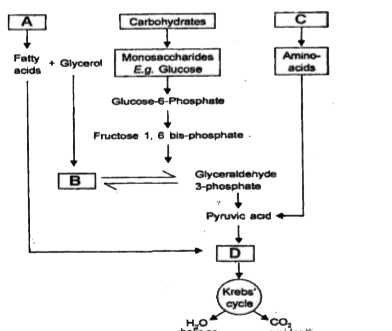Interrelationship Among Metabolic Pathways Showing Respiration Mediated Breakdown Of Different Organic Molecules To Co2 And H20
Step by step video & image solution for Interrelationship Among Metabolic Pathways Showing Respiration Mediated Breakdown Of Different Organic Molecules To Co2 And H20 by Biology experts to help you in doubts & scoring excellent marks in Class 11 exams.
Updated on:21/07/2023Similar Questions
Knowledge Check
Which of the metabolities is common to respiration mediated breakdown of glycerol, carbohydrates and proteins.
APyruvic acidBAcetyl CoACGlyceraldehyde 3-phosphateDpyruvic acid and Acetyl CoASelect the wrong option.
I. Fermentation partial breakdown of glucose but aerobic respiration is the complete break down of glucose in CO2+H2O
II. NADH + H+Very slow−−−−−−−→FermentationNAD+
III. NADH + H+Very fast−−−−−−−−−−→Aerobic respirationNAD+
IV. In respiratory pathway gylcerol changes into DHAPANoneBAllCIDIII and IVAssertion :- Aerobic respiration yields more energy than anaerobic respiration.
Reason:- In aerobic respiration there is complete oxidation of organic substances in presence of oxygen and release all hydrogen and CO2.AIf both assertion and reason are true and reason is the correct explanation of assertion.BIf both assertion and reason are true but reason is not the correct explanation of assertionCIf assertion is true but reason is false.DIf both assertion and reason are false.
Respiration in plants || Shuttle System in Aerobic Respiration || Alternate Pathway OF Aerobic Respiration || Interrelationships OF Respiratory Pathways OF Different Substrates || Respriratory Pathway is an Amphibolic Pathway || Factors Affecting Respiration
View Solutioninterrelationship among respiratory path ways OF different substrates ; respiratory pathway is an amphibolic pathway. respiratory quotient (r.q)
View SolutionRead the following statements a. Removal of CO2, from amino acid histidine converts it into an amine. b. Metabolites are converted into each other in a series of linked reactions called metabolic pathways. c. There is no uncatalyzed metabolic conversion in living systems. d. In living systems, the proteins with catalyti power are known as enzymes. How many above statements are correct?
View SolutionA catalyst increases the rate of chemical reaction by providing an alternative reaction pathway which lowers the activation energy than the reaction pathway in its absence. A catalyst is not consumed and therefore does not appear in the chemical equation for the reaction. A homogenous catalyst is in the same phase as the ractants whilst a heterogeneous catalyst is in a different phase.
The complex [Co(NH3)3F]2++H2O→[Co(NH3)5(H2O+F−]3+
and Rate =k[complex]a.[H+]b
The reaction is acid catalysed , i.e. [H+] does not change during the reaction . Thus, rate =k'[complex] where, k'=[H+]b

From the above data, value of a is :
View SolutionA catalyst increases the rate of chemical reaction by providing an alternative reaction pathway which lowers the activation energy than the reaction pathway in its absence. A catalyst is not consumed and therefore does not appear in the chemical equation for the reaction. A homogenous catalyst is in the same phase as the ractants whilst a heterogeneous catalyst is in a different phase.
The complex [Co(NH3)3F]2++H2O→[Co(NH3)5(H2O+F−]3+
and Rate =k[complex]a.[H+]b
The reaction is acid catalysed , i.e. [H+] does not change during the reaction . Thus, rate =k'[complex] where, k'=[H+]b

Overall order of reaction is
View Solution


